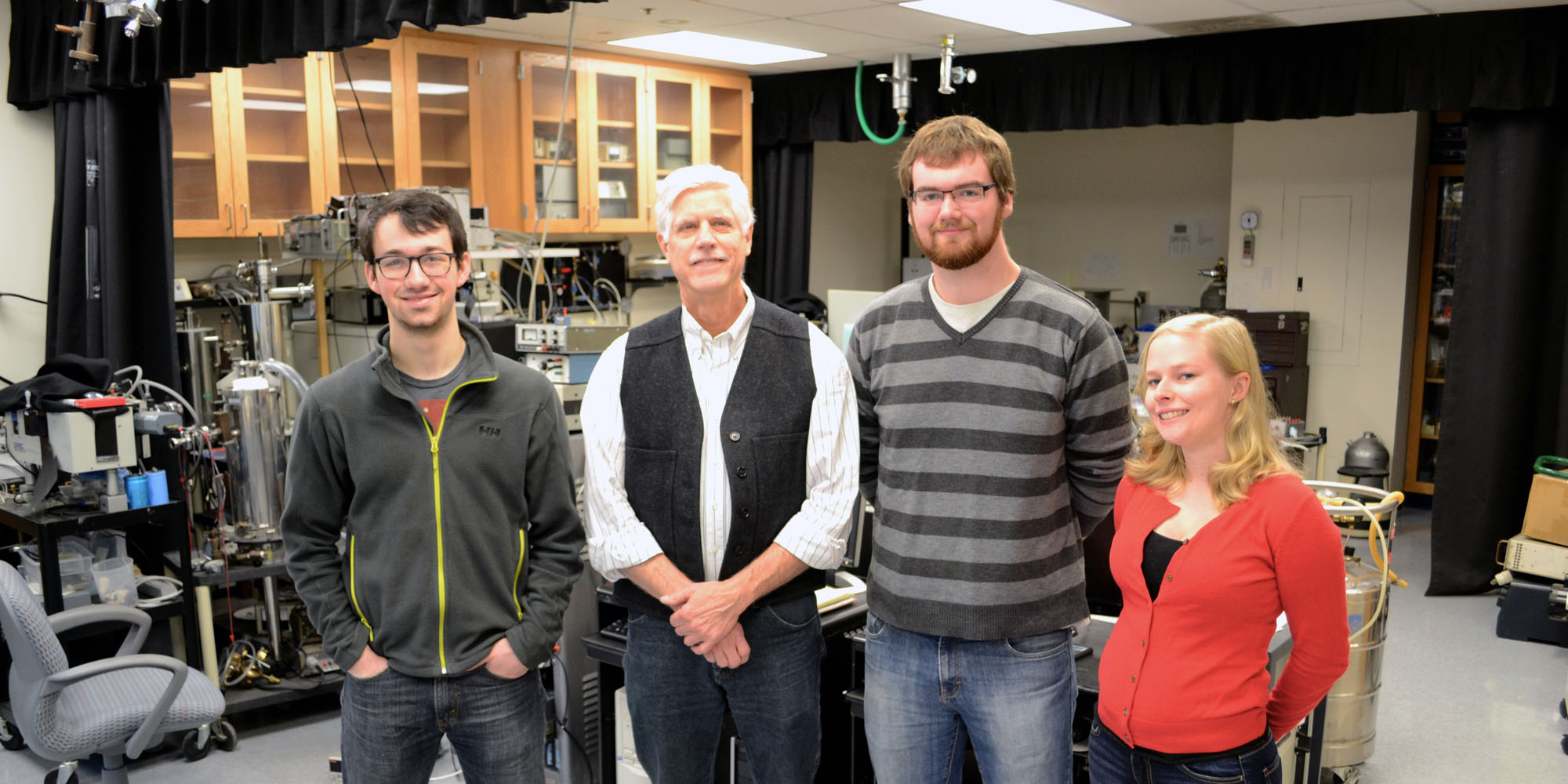by Jeff Cutler
Leveraging a grant for his Revolutionizing Magnetic Electronics without the Magnetism, physics professor Don Heiman and several students are focused on finding the best and most cost-effective way to store and process information. Their work begins as individuals and businesses find themselves overwhelmed by the amount of data they have to deal with daily. According to Heiman, a 2013 estimate said the Web contains and processes four trillion gigabytes of data (equal to a trillion full-length movies) and that amount is only expected to grow. Finding a better way to store, manipulate and share the enormous amount of data is what he’s after.
Heiman explains that his team is investigating a new class of magnetic-like materials for applications in computer memories, novel transistors and the building blocks of quantum computers. These materials are unique “antiferromagnets,” that are essentially nonmagnetic, but the current-carrying electrons remain magnetic. Such novel materials could form a cornerstone of the rapidly expanding field of magnetic electronics, referred to a “spintronics” (the “spin” in spintronics refers to the intrinsic magnetism of all electrons that arises from the fact that their charge spins like a top).
But finding an ideal solution has its challenges. One of which is developing nanometer-size magnets that are less affected by the physics of magnetic fields. These new antiferromagnets would be capable of operation without spreading their magnetism and compromising the function of other nearby components, but would be more versatile in how they’re built and located.
“Imagine that you are trying to place two tiny electronic devices near each other, but the magnetic field of one compromises the operation of the other one,” said Heiman. “You cannot afford to place them so far apart and waste 90% of the space. Our novel antiferromagnets do not have these “fringing” magnetic fields and could be located very close together.”

left to right, Professor Don Heiman, Gabriel Player, Michelle Jamer, and Jack Heimann
He explains that the iPhone has more than 1 billion transistors inside it. Using new materials, these transistors could consume much less energy and could be an “avenue toward a ‘quantum computer’ that can do certain types of computations millions of times faster than current computers.”
One of the first steps in this solution is actually making these materials antiferromagnetic. These would need to be synthesized in the forms most amenable to the products in which they’d be placed. Unfortunately, the process is an arduous one with lots of trial and error. And there are specific national laboratories where some of this work is best performed, making it a logistics game of timing and experimentation.
“Characterizing the properties requires state-of-the-art facilities using X-rays, neutrons, magnetic fields, and ultra-low temperatures,” said Heiman. “In order to use national X-ray synchrotron facilities in New York and Chicago, and neutron facilities in Tennessee we have to apply three months in advance to get 3-5 days of experimental time.”
From this ongoing work, the information will help Heiman and the team with optimizing the synthesis of thin films and nanostructures used in the final antiferromagnets. He says an additional challenge is that these devices require layers of materials that are only a few nanometers thick (this is 10,000 times smaller than the diameter of a human hair). Making these layers very smooth and without stretching the intrinsic crystal lattice is another hurdle they have to surmount.
Heiman sees the process as one that can assist multiple industries and entire populations. New devices and storage techniques are going to be necessary as we continue to produce more information and his solution could be the way to make the collection, storage and manipulation of this data more efficient.
“Our unique antiferromagnets would be an ideal solution,” said Heiman. “It could improve the storage density of information, speed of reading magnetic information, lead to quantum computers, and lower the power consumption of electronics.”
Heiman credits his team for getting closer to a solution. Aside from himself, Heiman says the majority of the work is carried out by a graduate student, Michelle E. Jamer, with help from undergraduate students, Gabriel Player and Jack Heimann (no relation). Support from Northeastern University personnel and those at other local universities has also been helpful. Ultimately, there are larger science projects that might benefit from Heiman’s research…even those that focus on the secrets behind human physiology and life itself.
“In the future, medicine and other sciences will require larger and larger amounts of information to be stored and analyzed,” Heiman said. “Consider the information required in understanding the human genome and brain.”
Heiman’s $340,000 research grant is for three years and was awarded by the National Science Foundation.

